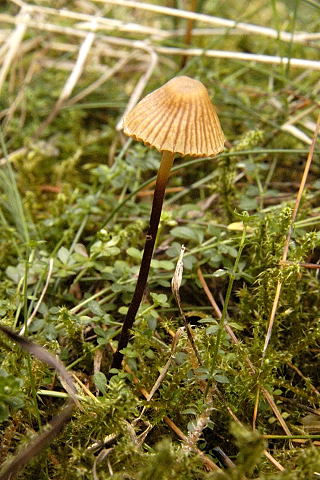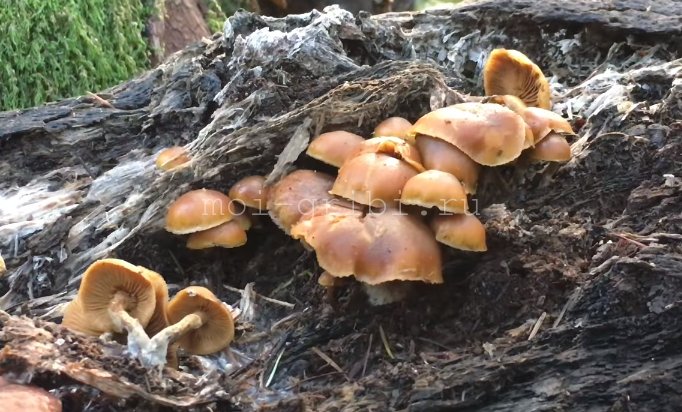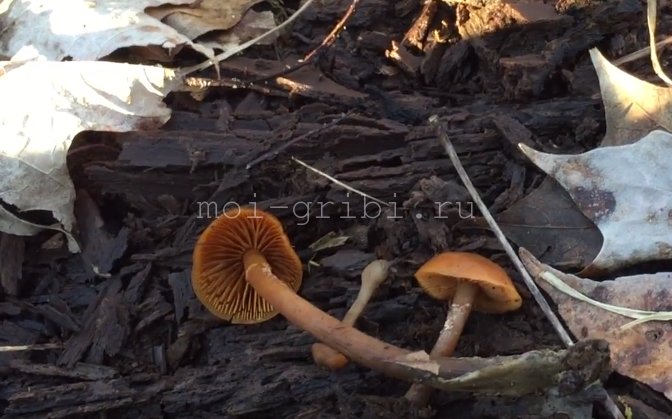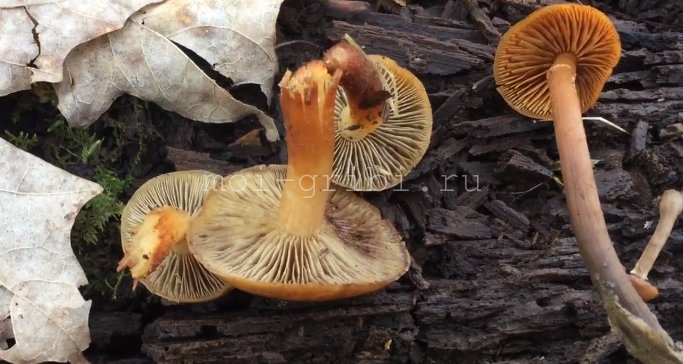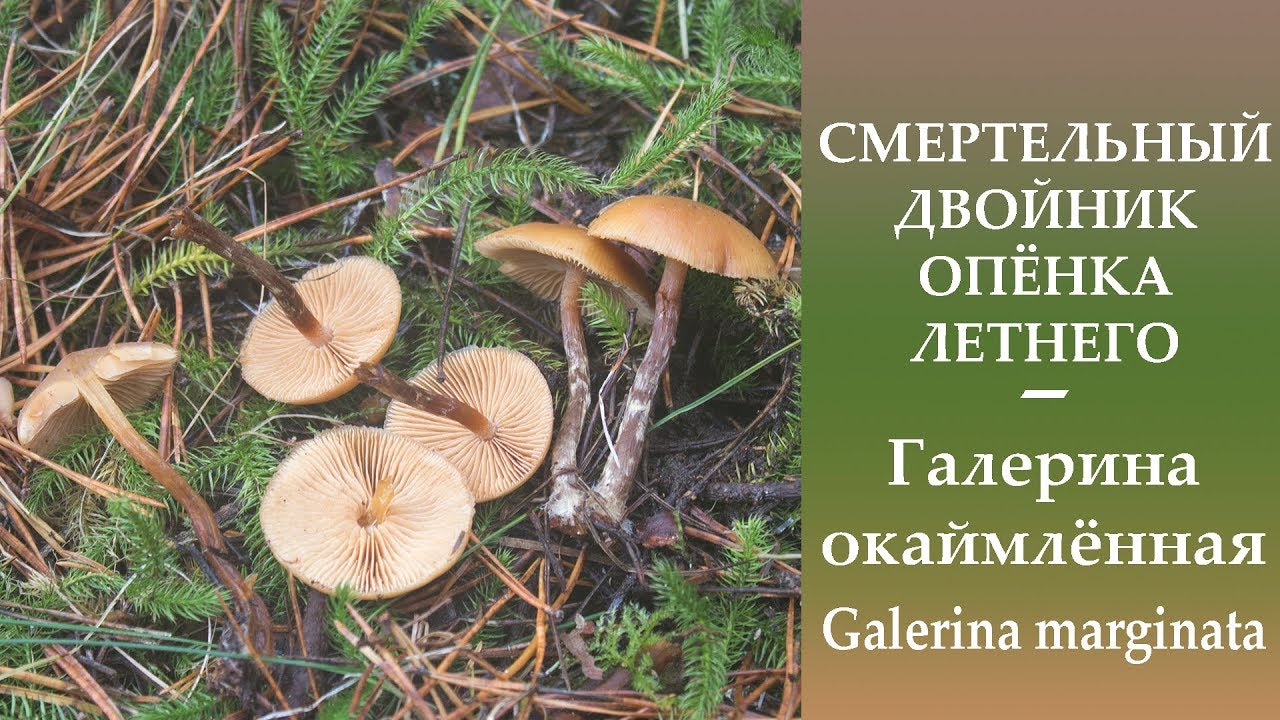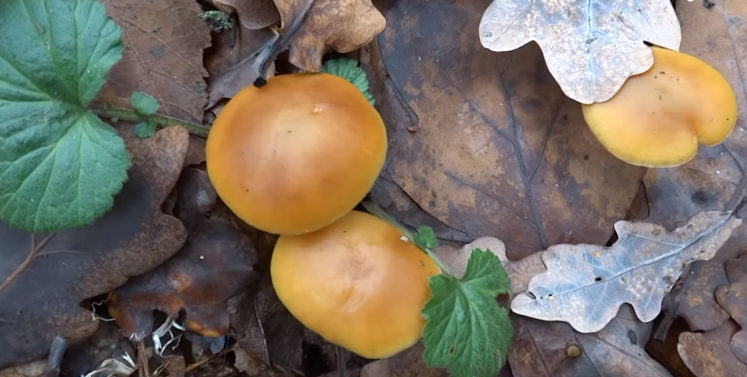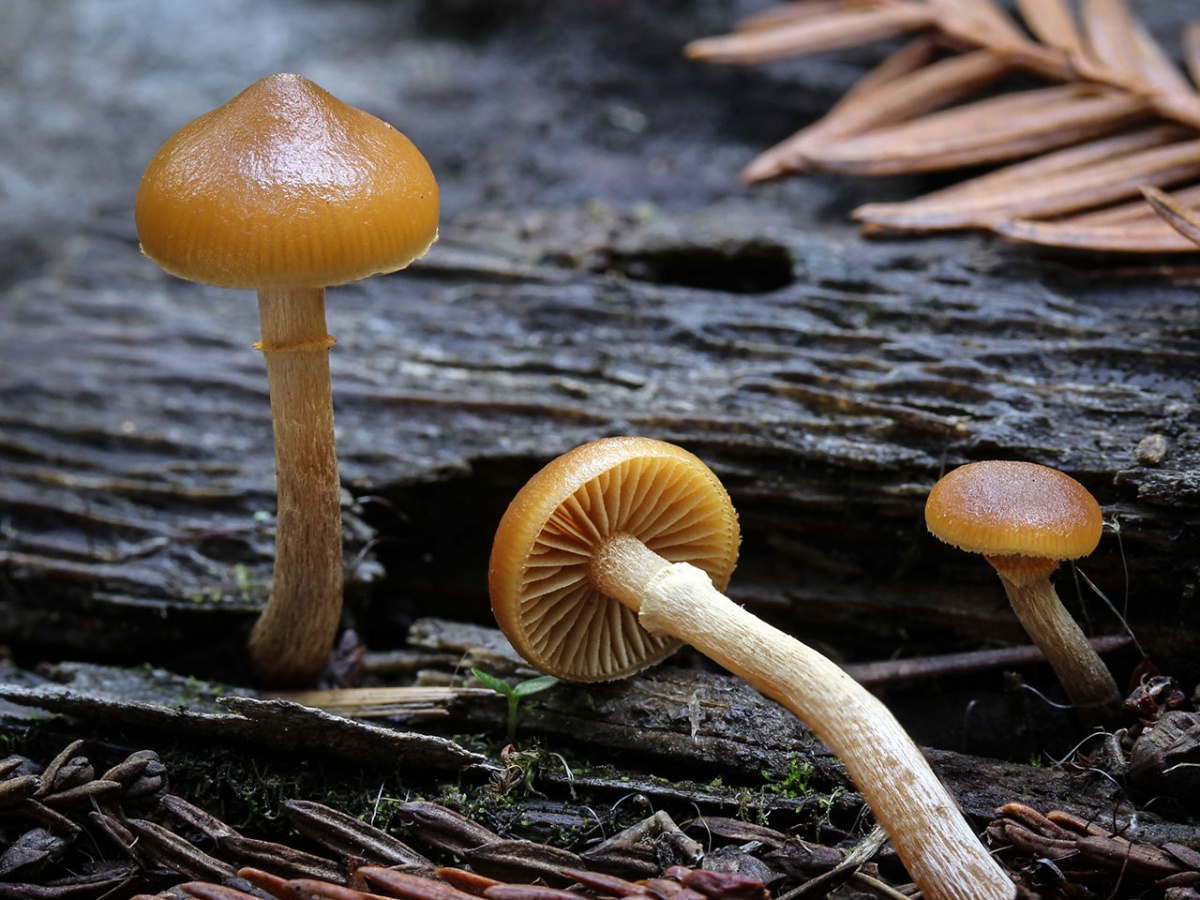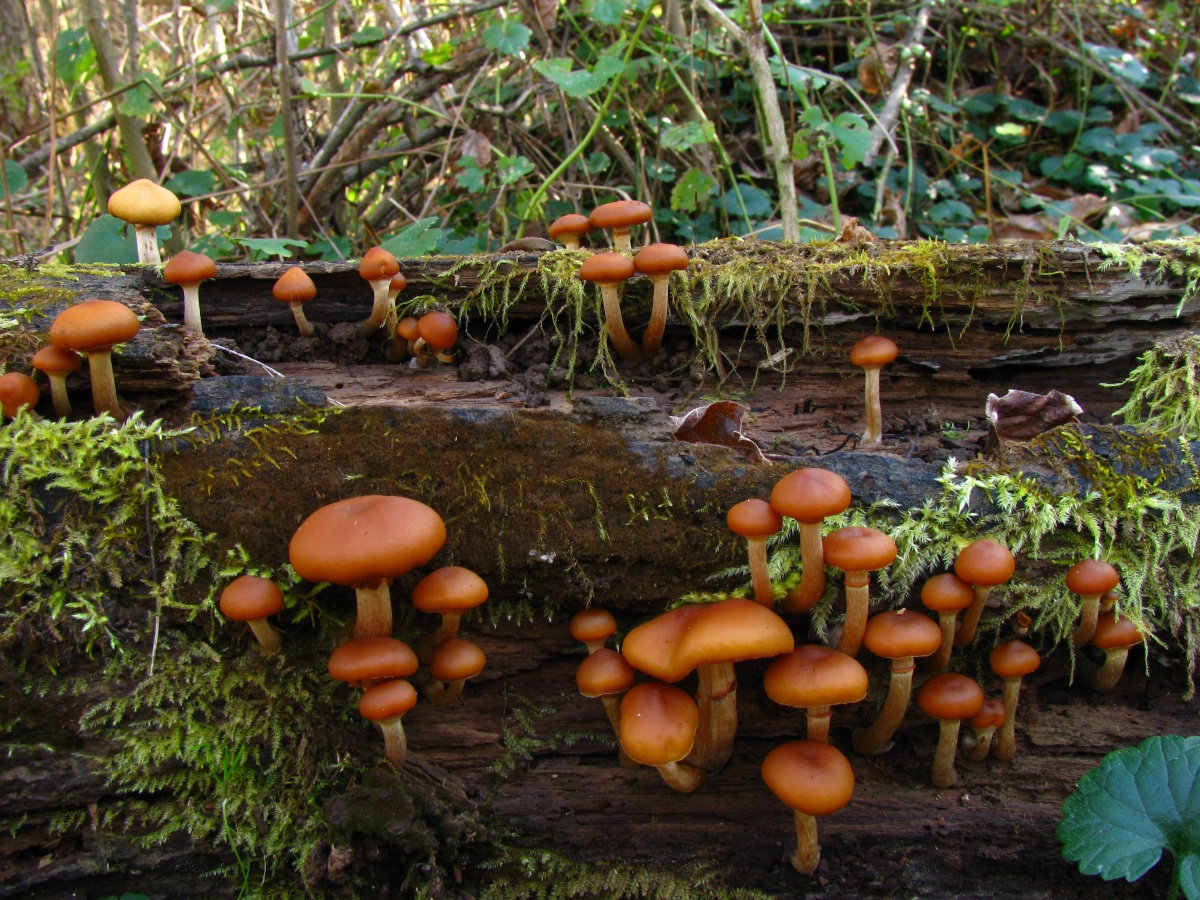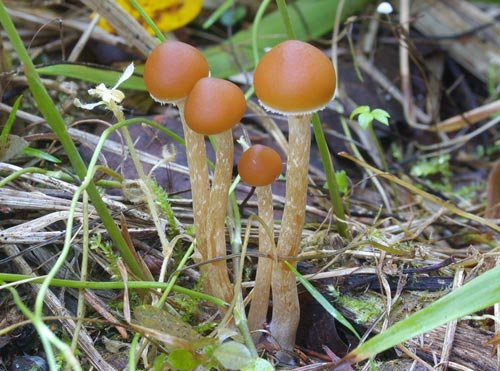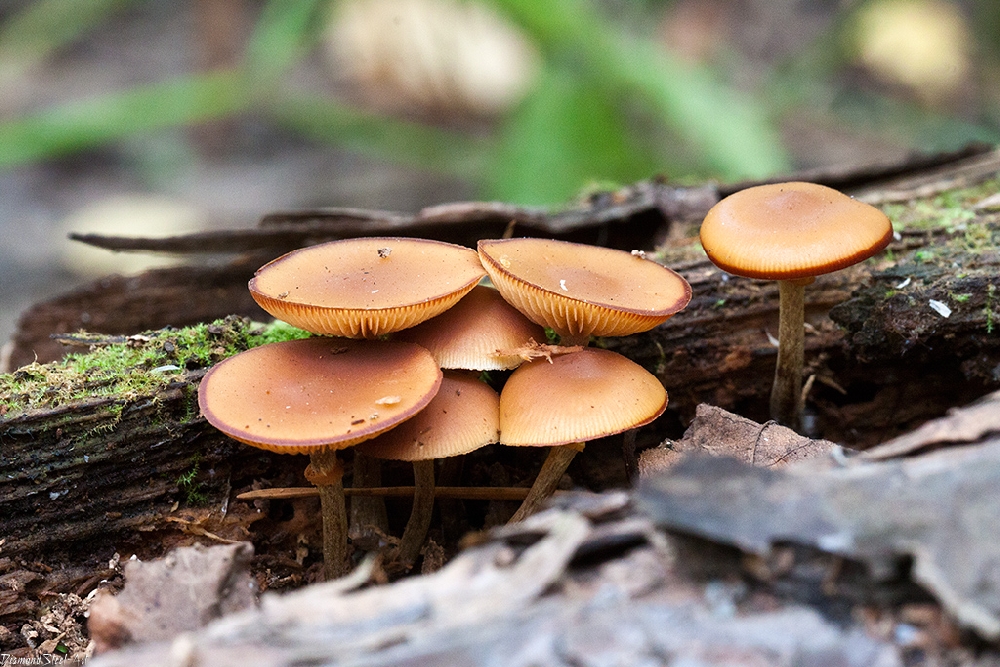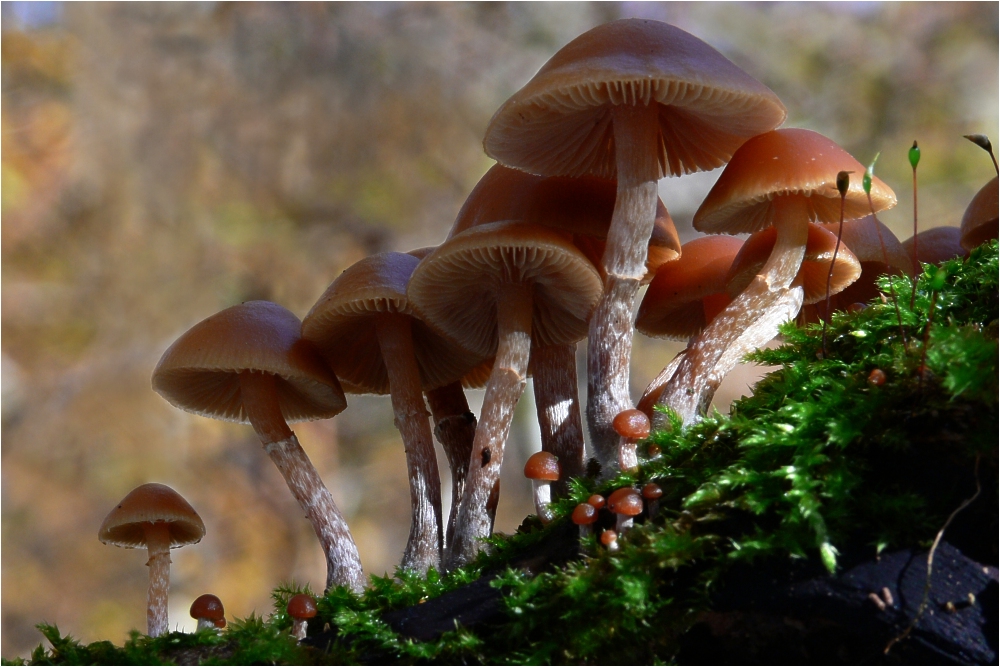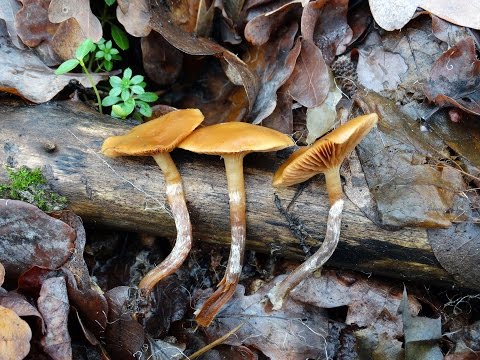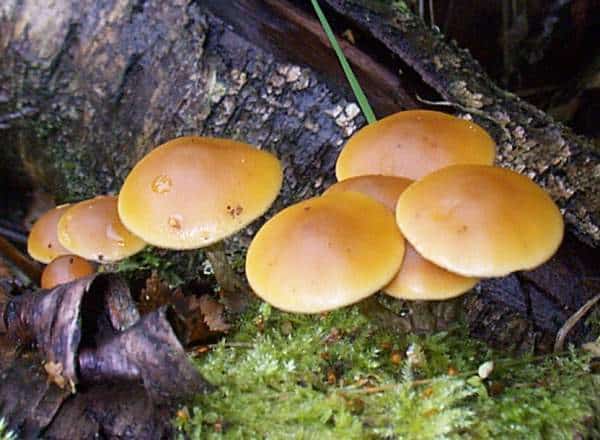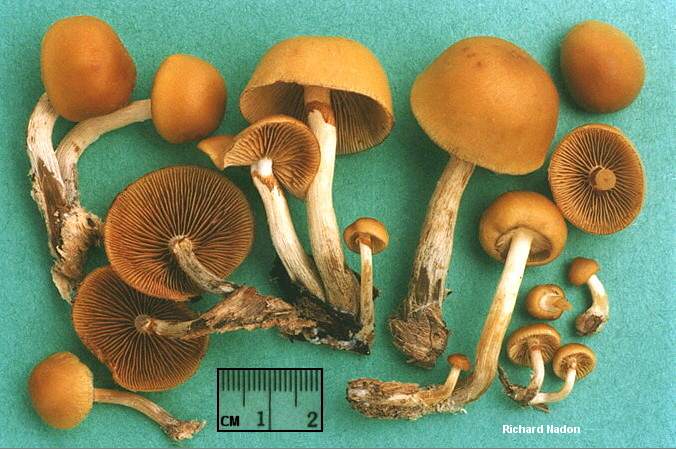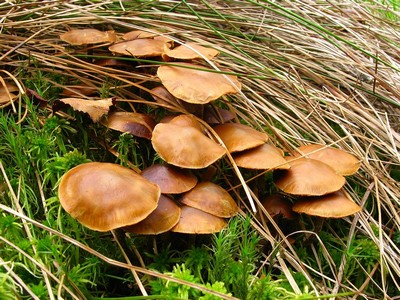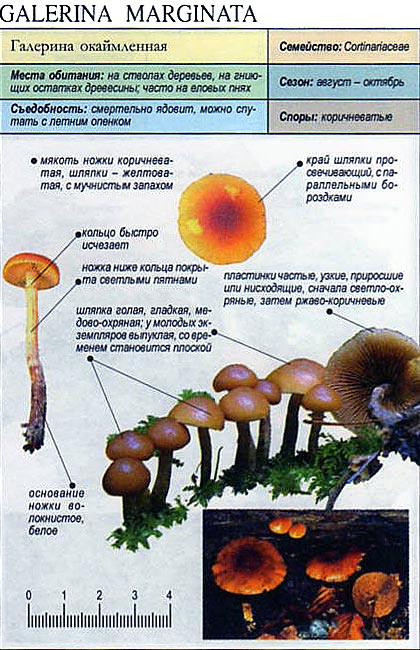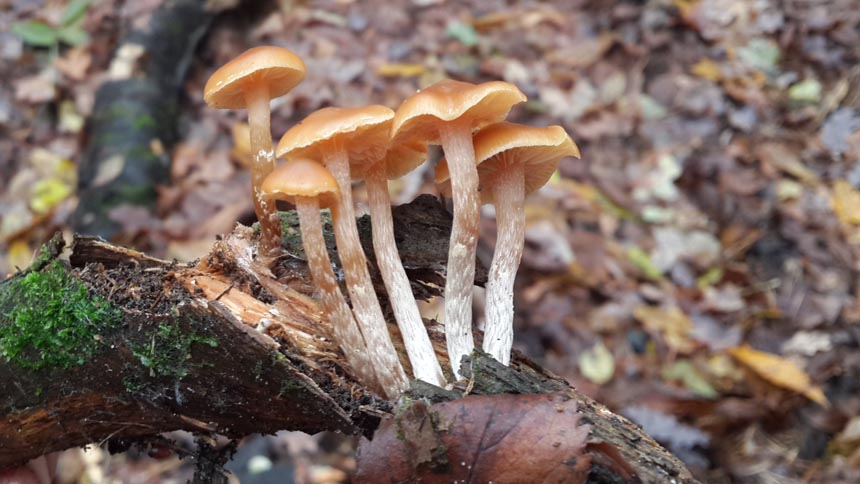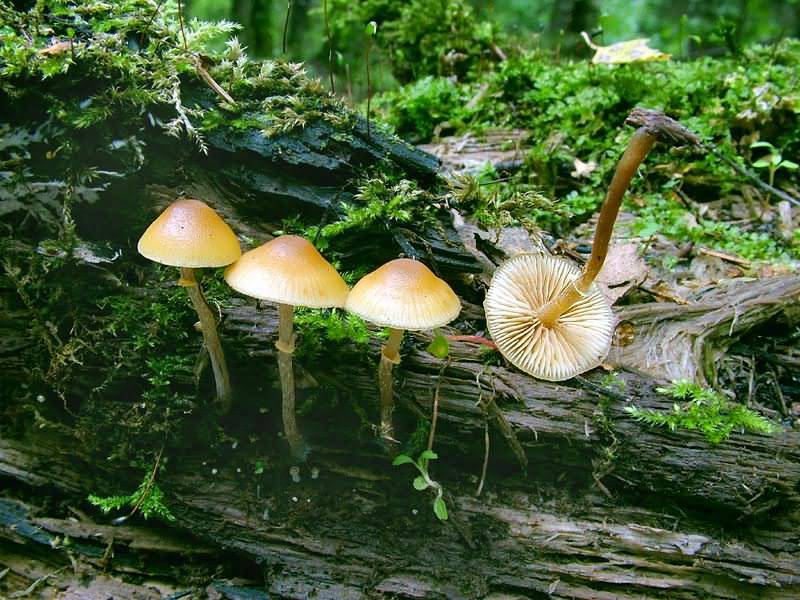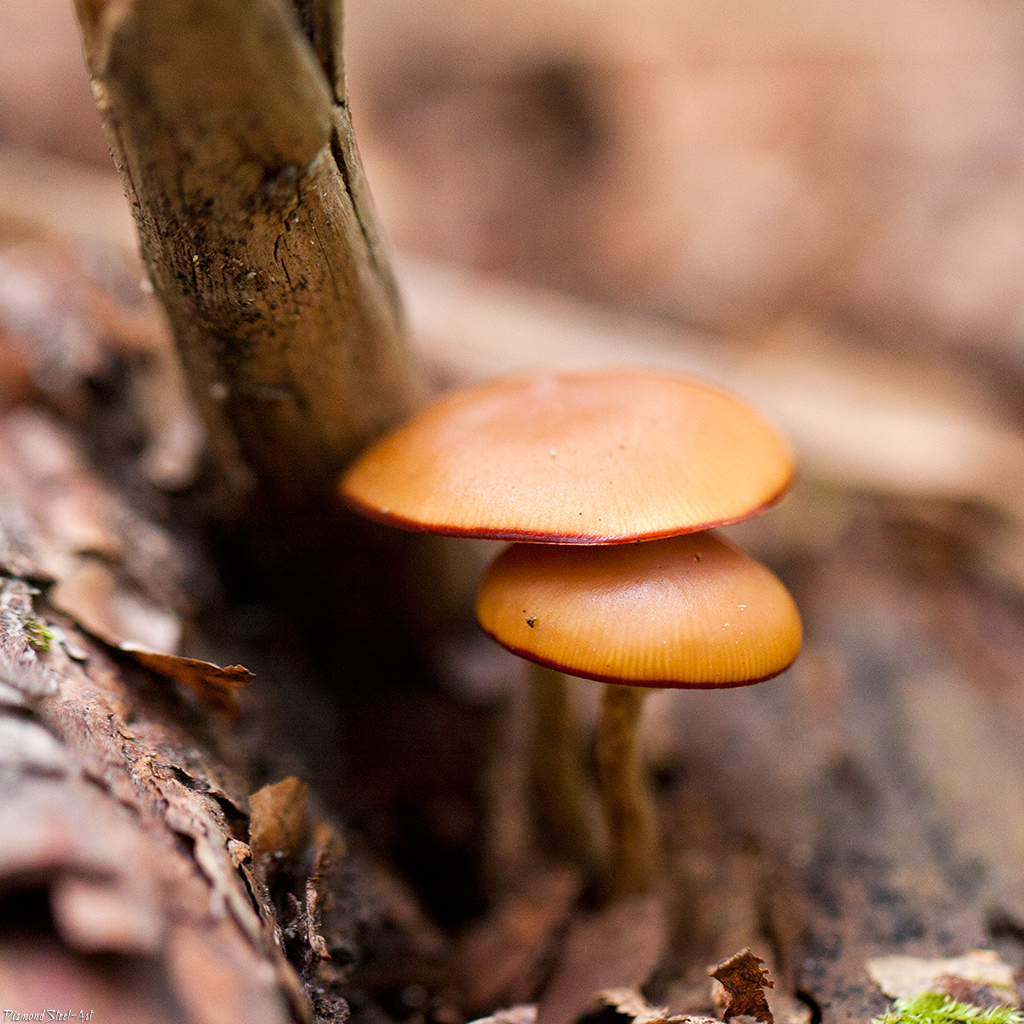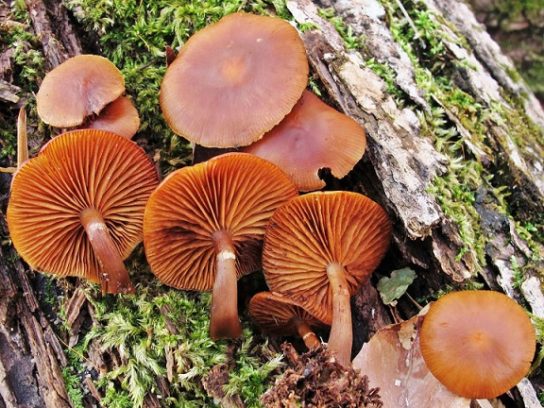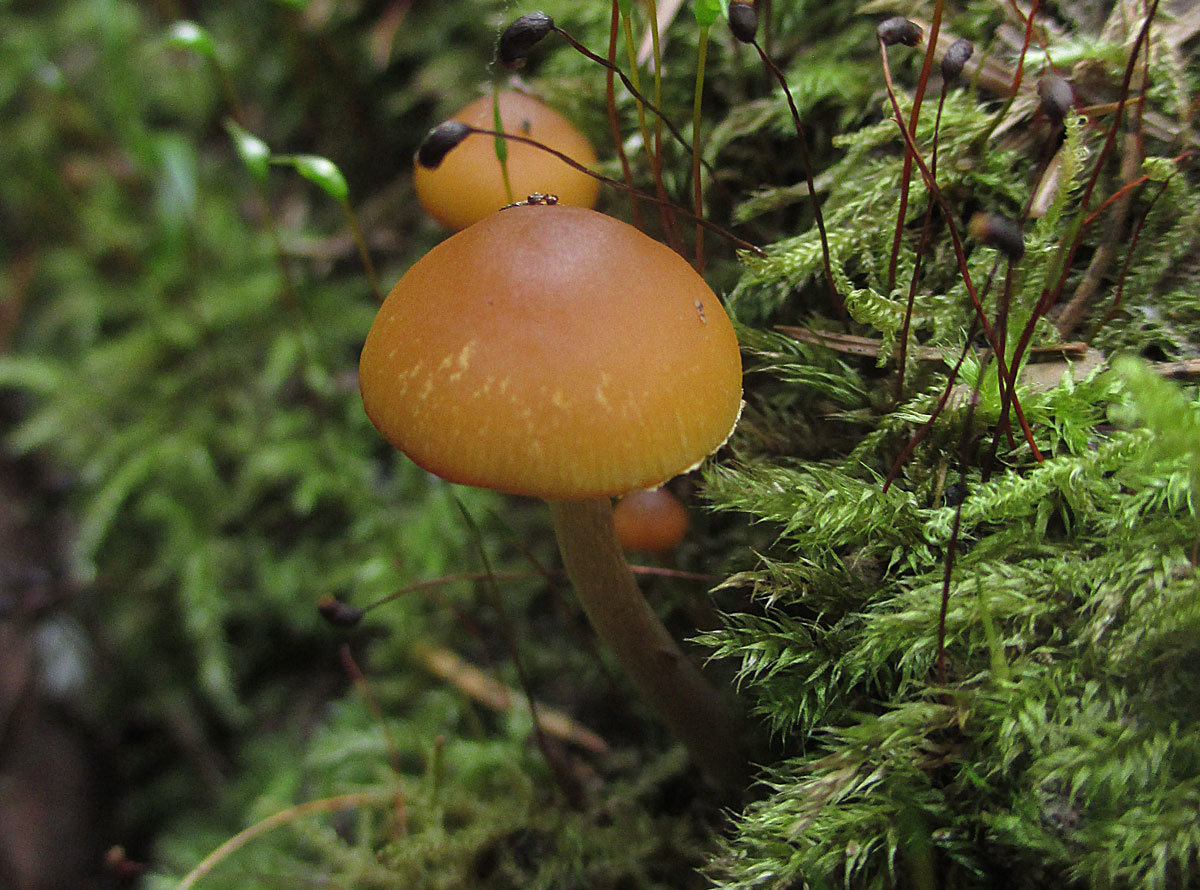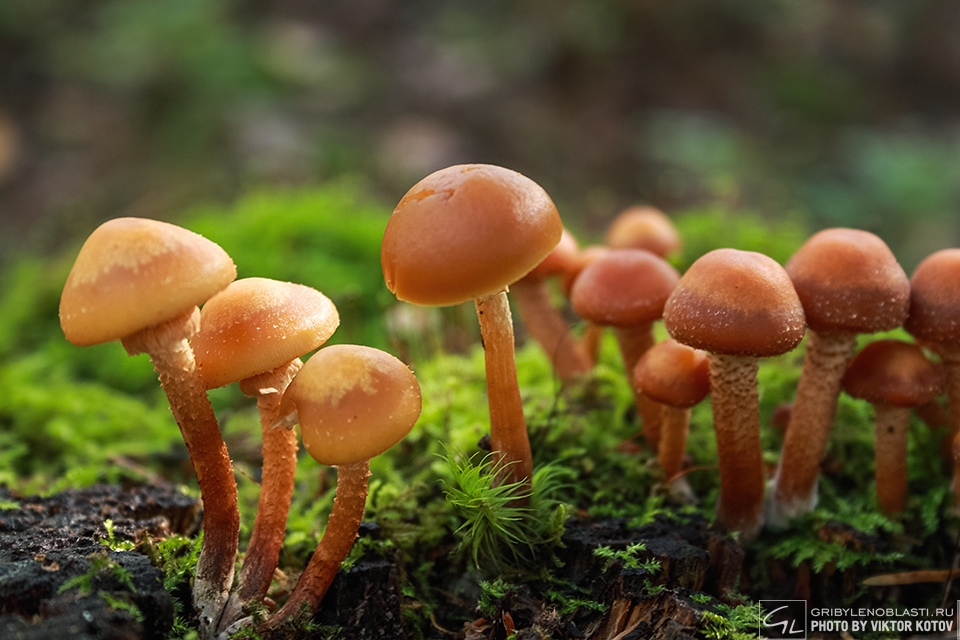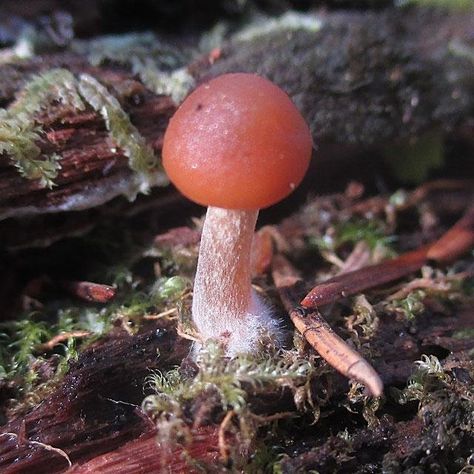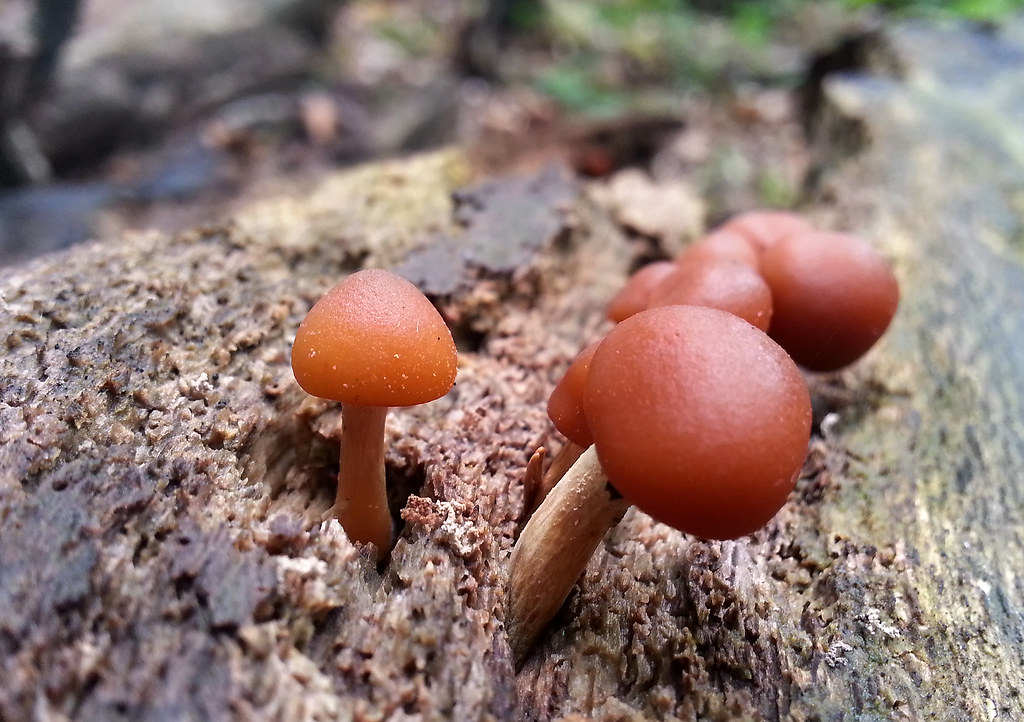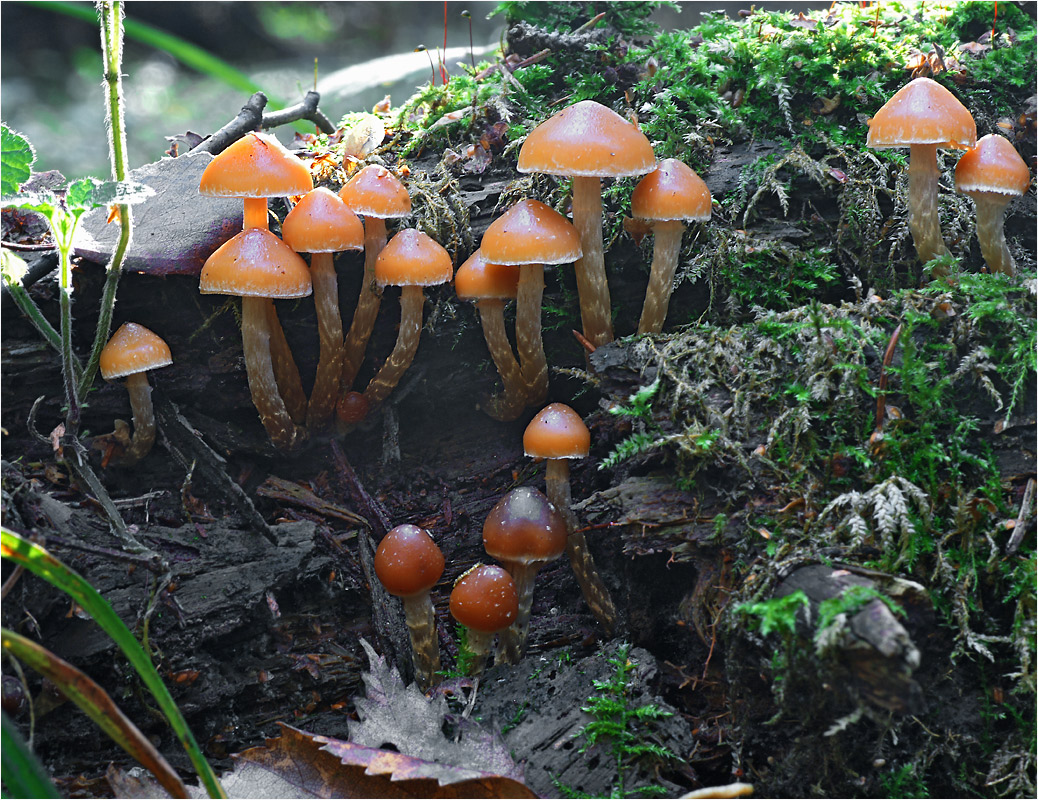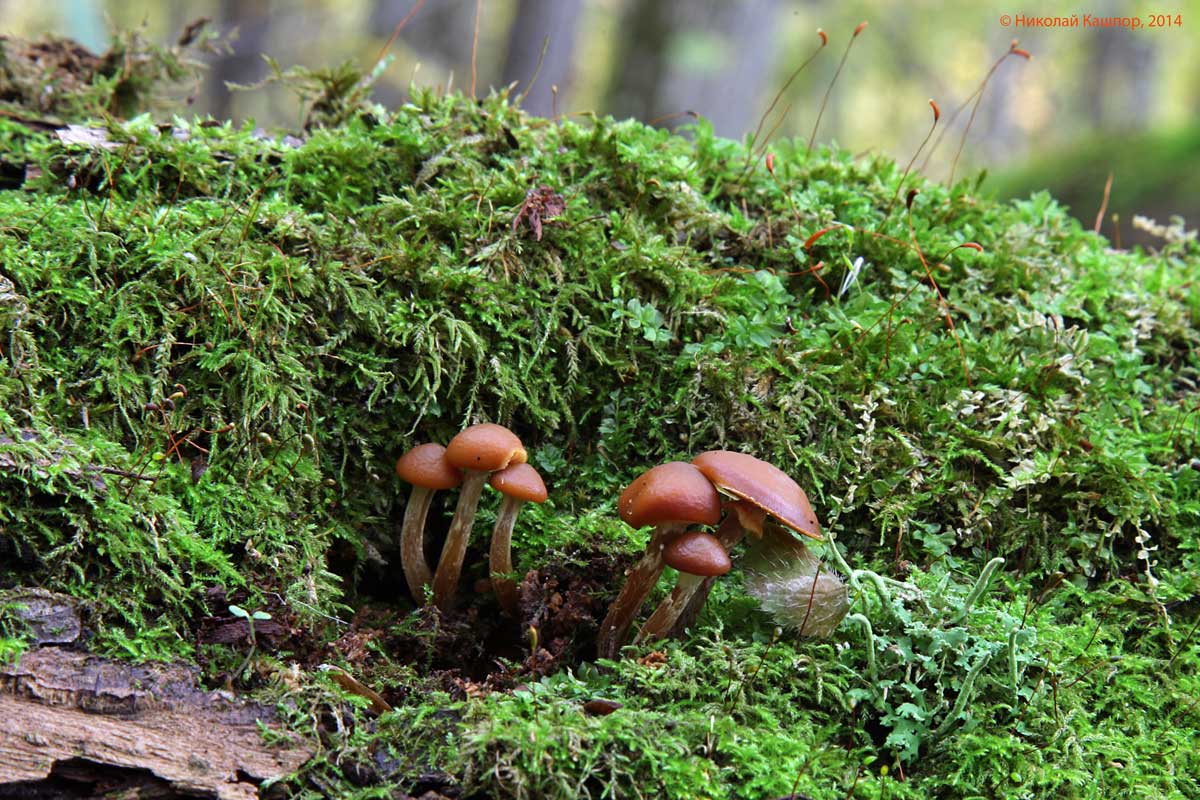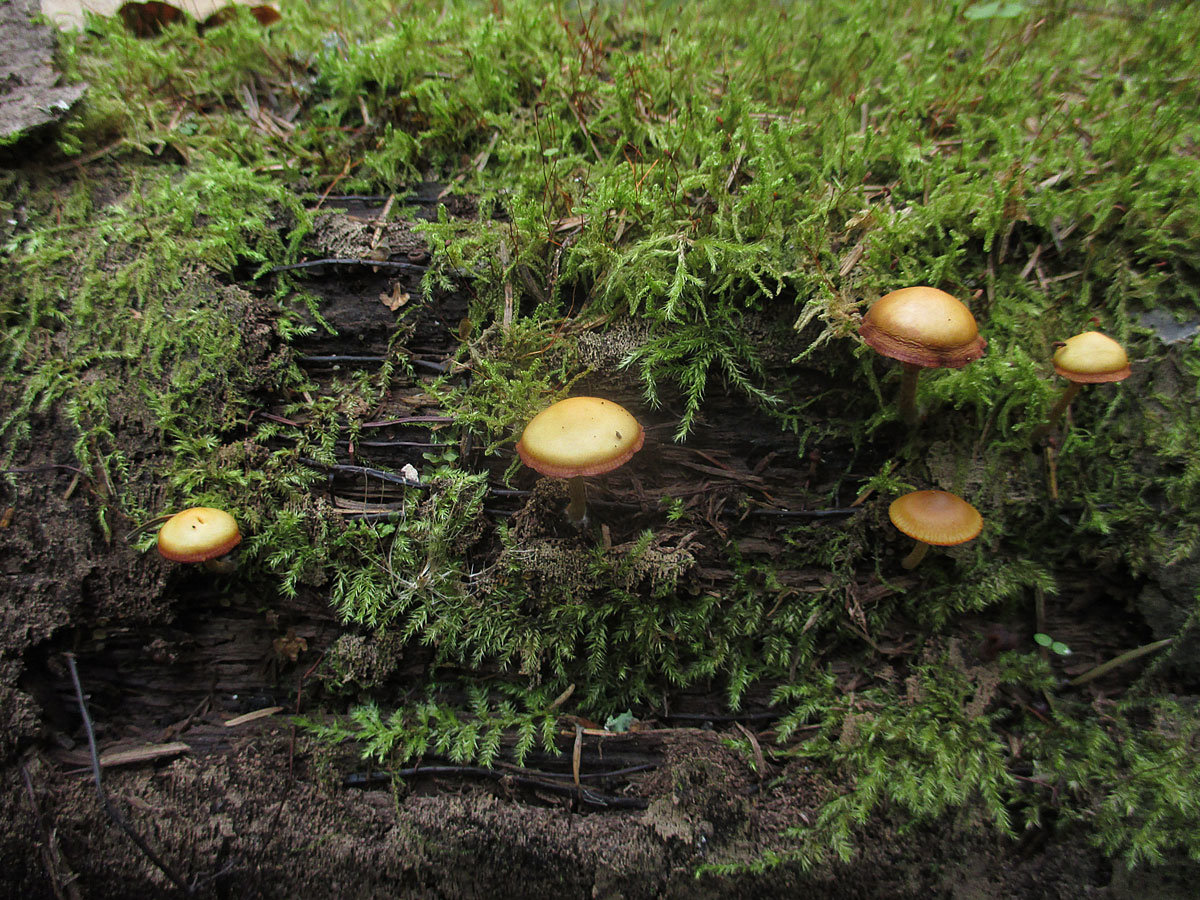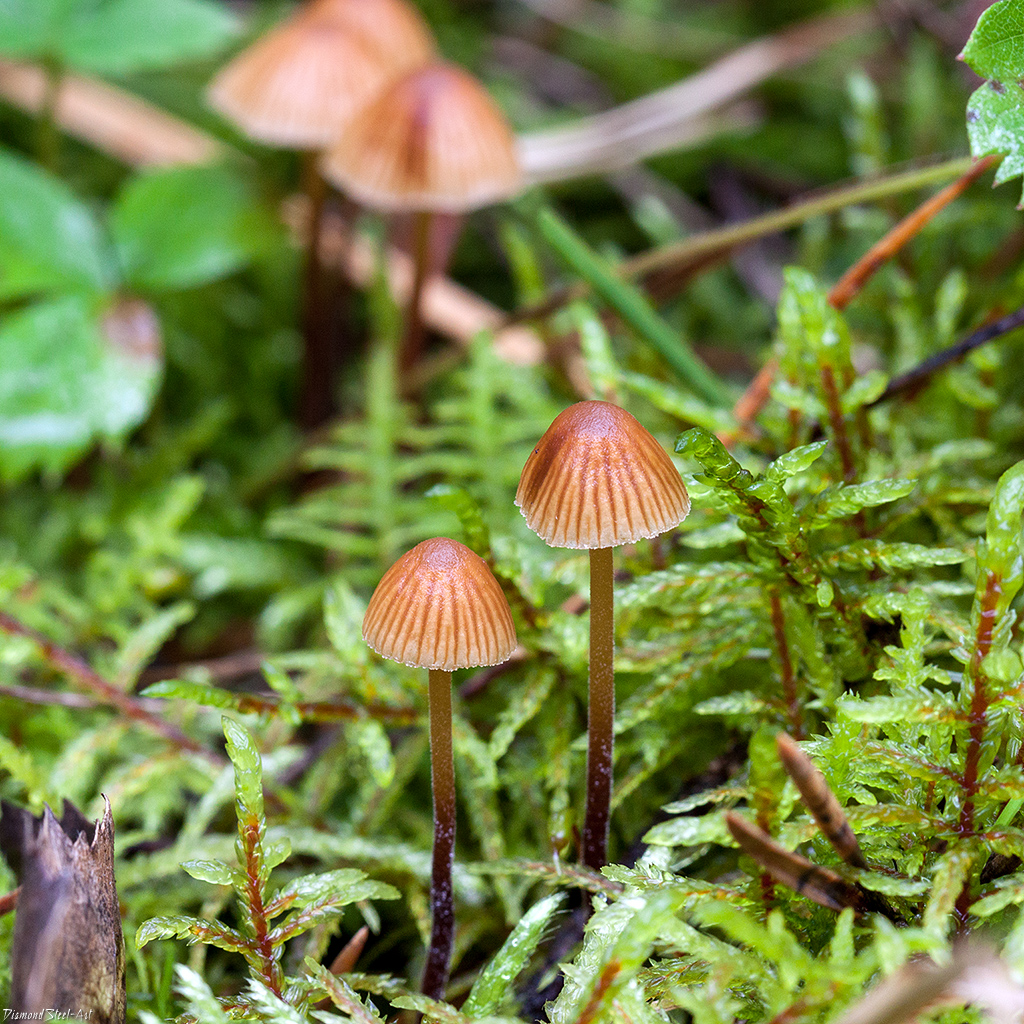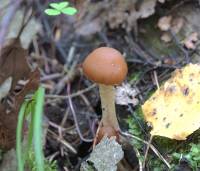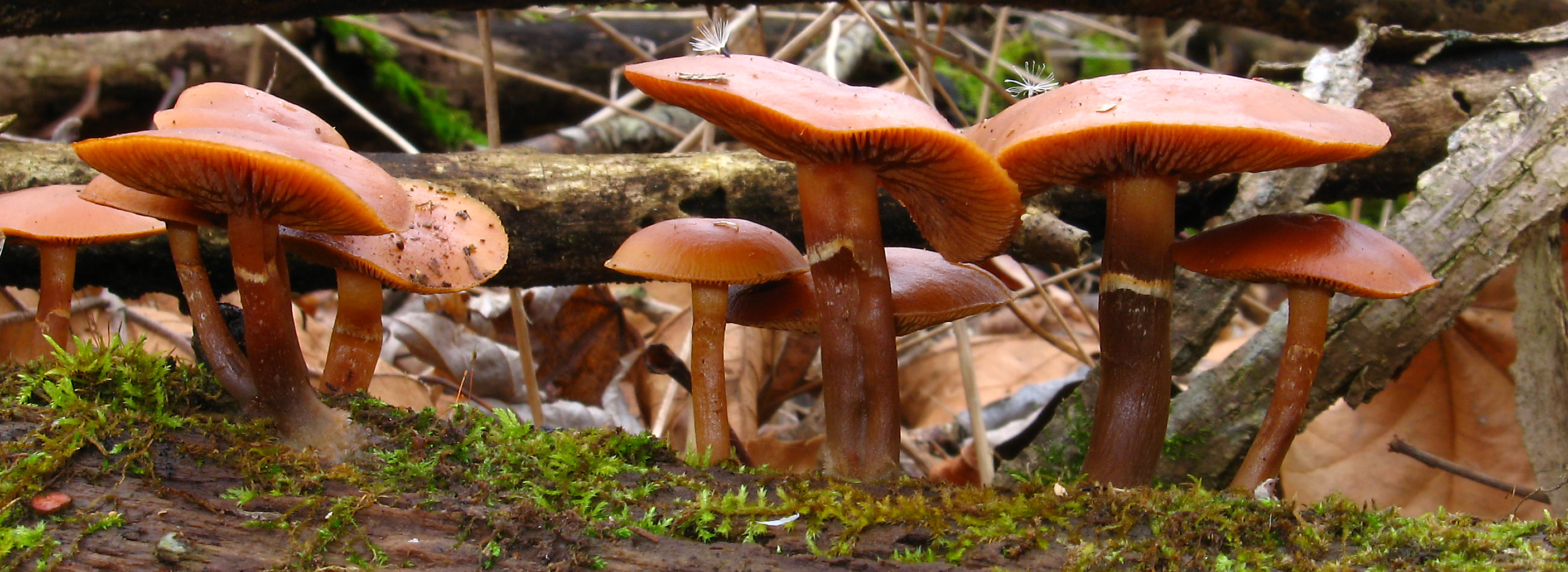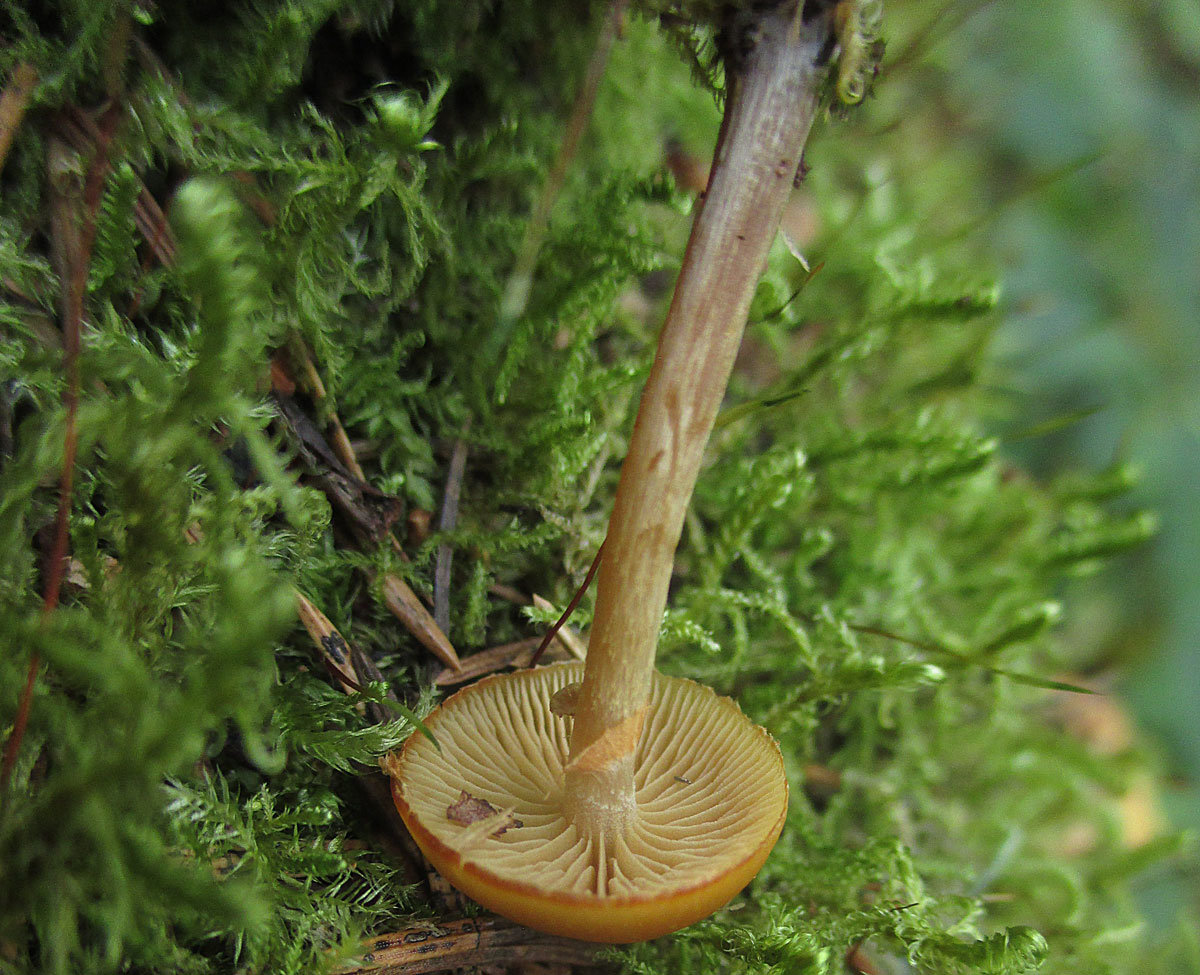Area
Galerina edged is a reducent (saprob), receiving nutrients through the destruction of organic matter. It has most of the main classes of secreted enzymes that dissolve polysaccharides of plant cell walls and, therefore, has been used as a typical reducer in recent studies of ectomycorrhizal fungi. It usually grows on or near a coniferous tree, although sometimes it is also found on deciduous trees. Fruiting bodies can grow alone, but to a greater extent they grow in groups and appear in summer or autumn. They can sometimes grow on underground wood and thus appear to grow on soil.
Galerina bordered is widespread in the northern hemisphere: in North America, Europe, Japan, Iran, continental Asia and the Caucasus. In North America, it has been found in the north even in the boreal forests of Canada and in the subarctic and arctic places in Labrador and in the south up to Haliska in Mexico. Also found in Australia.
Poisoning symptoms and first aid
The fruits of gallerina contain amatoxins (amanites). These same substances are found in such deadly mushrooms as pale toadstool, smelly and spring fly agaric species. The likelihood of death after ingestion of the Amish is very high. Only 0.1 mg of toxin is enough for 1 kg of human body weight.
Gallery poisoning is accompanied by the following symptoms:
- severe abdominal pain;
- upset stool;
- nausea and vomiting;
- headache;
- visual impairment.
At the slightest suspicion of poisoning, an ambulance must be called immediately. A small amount of food should be handed over with the victim for laboratory analysis for toxins.
- First of all, you need to stop intoxication. For this, the victim is forced to drink a weak solution of potassium permanganate in order to clear the stomach by causing an attack of vomiting.
- Toxins that have already been absorbed into the bloodstream must be removed from the body. A poisoned person is given sorbing drugs.
- Further, the victim must be provided with peace. He is wrapped in a blanket to improve blood circulation. To prevent dehydration, the person is given plenty of water to drink.
First aid for poisoning with a poisonous mushroom is aimed exclusively at alleviating the condition of the victim before the arrival of doctors. Further, he will need serious medical intervention, since the human body cannot independently fight this degree of intoxication.
Important! The insidiousness of mushrooms containing amatoxins lies in a latent, asymptomatic period that follows immediately after the poison enters the body.
A person may not experience discomfort for 6 or more hours after intoxication. Meanwhile, the toxins are doing their job, affecting the liver, cardiovascular system and central nervous system. After the latent period, medicine often turns out to be powerless: the victim cannot be saved.
The bordered gallerina is easy to confuse with some edible varieties of honey agarics. The consequences of such confusion can be fatal. Experienced mushroom pickers recommend refraining from collecting honey agarics in coniferous plantations for the period of fruiting of poisonous mushrooms.
Description and distribution of the fungus
Galerina marginata is included in the family of strophariaceous agaricomycetes
Since the danger of this mushroom is beyond doubt, it is important to know its distinctive features:
- The hat is brown in color, can also have a yellowish tint, reaches 4 cm in size, smooth, slightly shiny. At the beginning of its growth, it is convex, it can have the shape of a bell, and bends inward along the edges. As the cap develops, it straightens to a flat state, its edges become translucent with noticeable parallel grooves on them.
- Has narrow, closely spaced plates. At first they are light in color, and when the spores mature, they change to brown with a rusty tint. When emerging, young mushrooms are provided with a film from the bottom of the cap, which then breaks and hangs like a ring on the stem.
- Spores of the bordered gallery are painted in a pronounced rusty color.
- The leg is thickened at the base, reaching a maximum length of 5 cm and a thickness of half a centimeter. It is colored brown with a yellow ring at the top, which later disappears. Above the ring, the leg is covered with a bloom of a mealy structure, and below it, its color is closer to the color of the cap. It is hollow inside.
- The pulp has a persistent powdery aroma. In color, it is more yellow in the cap of the mushroom and more brown in its stem.
Bordered gallerina is quite widespread. It can be seen in the forests of Asia, Europe, North America and Australia. In Russia, gallerina is found in the European part, including the Crimea and the Caucasus, as well as in the Far East, the Urals and southern Siberia. The fungus prefers dead coniferous tree trunks, even if they lie shallow in the ground. It can also live in mosses or on tree roots protruding from the soil. The fruiting bodies of the bordered gallerina appear in August and occur until October.
Poisonousness of gallerina moss
These mushrooms belong to the poisonous group. Galerina moss is not easy not edible, but it also carries a great fall for health and even human life. The peak fruiting of gallerina moss coincides with summer and winter mushrooms
Therefore, it is extremely important for mushroom pickers not to confuse these mushrooms. Outwardly, mushrooms and gallery owners are similar, they can be confused even by professionals, and even more so by amateurs
Other mushrooms of this genus
The bordered gallerina has a slightly larger hat - its diameter is 1-4 centimeters. At first, the shape of the cap is bell-shaped, but as it grows up, it becomes almost flat. The color of the cap changes depending on humidity, the most common is yellow-brown color, and in wet weather concentric zones appear. The flesh is thin and pliable, ranging in color from pale brown to almost white. The leg length is 2-5 centimeters, and the width does not exceed 0.5 centimeters. The leg is hollow, somewhat thickened in the lower part, with a yellowish or whitish ring. The part of the leg above the ring is covered with a mealy bloom.
This is a very poisonous mushroom with a flour smell. They contain the same toxins found in pale toadstools. The fringed gallery grows from June to October. These mushrooms settle in different types of forests, preferring decayed coniferous wood. They bear fruit in small groups.
Galerina ribbon-like has a hat with a diameter of no more than 0.4-3 centimeters. At first, its shape is convex, over time it becomes almost flat with a wide tubercle in the central part. The hat is capable of swelling under the influence of moisture. The color of the cap is honey-yellow with brown stripes. The length of the leg ranges from 3 to 12 centimeters, and the width does not exceed 0.2 centimeters. The leg is even, thin, hollow inside, brownish or light chestnut in color. Stem rings are usually not available.
Galerina ribbon-like grows in swampy areas, meeting among sphagnum and moss. These mushrooms are plentiful in Europe and America. Their toxicity is not fully understood, which is why it is highly undesirable to eat them.
Galerina marsh has a bell-shaped cap, which becomes prostrate as it grows, while a clearly visible sharp tubercle remains in the center. The diameter of the cap is 2-3 centimeters. The cap is watery, smooth, at a young age covered with the remains of a whitish blanket. The color of the cap is yellow-brown or whitish-yellow, but in old mushrooms the caps fade and become dark yellow. The leg is long, filiform, 8-13 centimeters high. The leg is extremely thin, light yellow in color, mealy. There is a white ring at the top of the leg.
Galerina marsh is widespread in forests of various types, most often it is found among sphagnums and in wetlands. These mushrooms are widespread in Europe and North America.They grow in small groups, and most often singly. Galerina marsh is not used in cooking, as it refers to poisonous mushrooms.
Galerina sphagnum has a hat with a diameter of 0.6-3.5 centimeters. Young mushrooms have a cone-shaped cap, but over time it becomes hemispherical. The surface of the cap is smooth, but sometimes fibrous. The hat is capable of absorbing moisture from the environment. The color of the cap is brown or ocher, as it fades, it becomes yellowish. The tubercle on the cap has a more intense color. The leg is thin, even, 3-12 centimeters long and 0.1-0.3 centimeters wide.
Sphagnum galleys grow from June to September. Their habitat is quite wide: South and North America, Europe and Asia. These mushrooms can be found almost everywhere on the planet, with the exception of the ice of Antarctica. They prefer damp places and swamps. These mushrooms can grow individually or in families.
Toxicity
Galerina edged is a very poisonous mushroom containing the same toxins that pale toadstool includes. Its toxicity has been known for over 100 years, starting in 1912, when the first fatal case was recorded in the United States. Then, reports of fatal gallery poisoning appeared repeatedly. In the period from 1978 to 1995 alone, 11 cases of serious poisoning were recorded, 5 of which ended in death. The remaining six patients in Michigan, Kansas, and Ohio have been successfully treated.
Signs of poisoning do not appear immediately, but a day after eating the mushrooms. The first symptoms are vomiting, diarrhea, profuse urination, and chills. After 3 days, these symptoms subside, a period of apparent improvement in the condition begins. But soon signs of jaundice appear, and the person dies as a result of impaired liver function. Often mistaken for another mushroom, the edged gallery enters the food. How to distinguish it so as not to become another victim, you can learn from this article.
The toxicity of the fungus is due to the presence of alpha and beta amantin toxins in it. These are bicyclic peptides, very poisonous, but slow-acting. Fresh content of amatoxins is 78-270 mcg per 1 gram of fruiting body, which is much higher than in the pale toadstool growing in Europe. This concentration is capable of killing a child weighing 20 kg when eating a dozen medium-sized mushrooms.
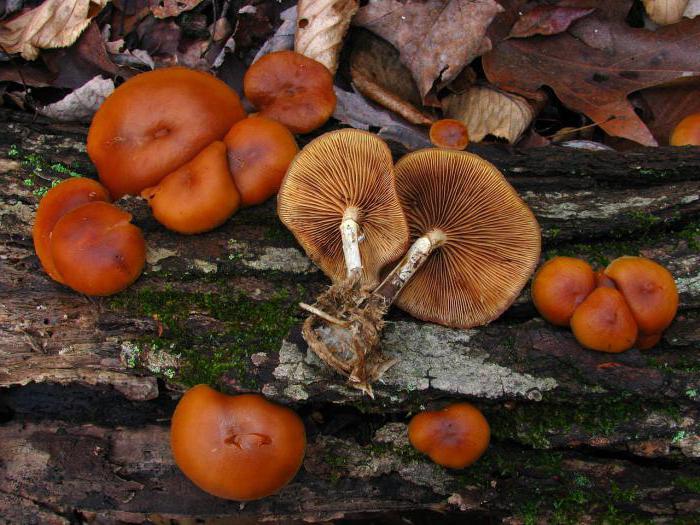
Poisonousness of the bordered gallerina
In one of the foreign sources, the bordered gallerina was called a good edible mushroom and generally combined it with summer honey. It is worth noting that to believe some translated reference books is not something that is impossible, but even dangerous, since they without a shadow of a doubt call deadly poisonous mushrooms edible, but, for example, Valui are classified as poisonous species.
If the bordered gallerina is really that dangerous, then it becomes clear why there are so many cases of poisoning with pale toadstools. After all, doctors are far from mycology, they can only state that the death came from a certain group of toxins, and in toadstools and bordered galleys the toxins are the same.
Other mushrooms of this genus
Galerina sphagnum is an inedible mushroom. Her hat is small - 0.6-3.5 centimeters in diameter. Its shape changes from conical to convex. The surface of the cap can be fibrous or smooth. The hat absorbs moisture. The color of the cap is ocher, brown or yellowish. The leg is long and very thin - its length reaches 12 centimeters, and its diameter does not exceed 0.3 centimeters. The leg is hollow inside, its color matches the cap.

Sphagnum gallery bears fruit from June to September. These mushrooms grow in the Americas, Europe and Asia. They settle in damp places and swampy areas. Sphagnum galleys grow in whole families.
Galerina moss is a poisonous mushroom. The diameter of the cap is small - 0.4-1.5 centimeters, its shape as it grows is conical, hemispherical and convex. The hat absorbs moisture and swells. Its color is light brown or honey yellow.The length of the leg reaches 4 centimeters, and the thickness is 0.2 centimeters. The color of the leg is light yellow. There is a ring on the leg, but in mature specimens it disappears.
The moss gallery bears fruit from August to September. These mushrooms grow in moss and on dead wood. They prefer to settle in small groups, and single specimens are extremely rare.

Poisoning symptoms and first aid
The bordered gallery contains the same toxins as the pale toadstool. It is a very poisonous mushroom. The poison begins to exert its destructive effect only 10-14 hours after it enters the body.

The first clinical signs of poisoning are: severe vomiting, diarrhea, frequent urination, and a lot of urine is excreted, a decrease in body temperature, convulsions.
The man is thirsty. After three days of torment, the patient gets better, but after a short time his condition worsens. He develops symptoms of jaundice, and if you do not provide help, then there is a high probability of death due to pathological changes in the liver.
When the first symptoms of poisoning appear, you must immediately call an ambulance. Before the arrival of the doctors, the patient's stomach is washed and put to bed. It is best to put warm heating pads on your hands and feet. The victim is given warm water. If he is very weak, then strong tea can be made for him.
When going into the forest to pick mushrooms, you must follow certain rules that can at least slightly protect the lover of "quiet hunting". But if, nevertheless, poisoning could not be avoided, then it is necessary to immediately provide assistance and call an ambulance. In this case, the consequences of poisoning with a bordered gallery will not be so serious and dangerous.
Description of the gallery bordered
The diameter of the bordered gallery cap is 1-4 centimeters. Its shape is bell-shaped at first, then it becomes convex, and with age it becomes flat. The cap of this mushroom is hygrophilous, that is, it absorbs moisture, and changes its appearance depending on the moisture content. The main color of the cap is yellow-brown and ocher, and in damp weather concentric circles become noticeable.

The flesh is thin, yellow-brown in color. The smell of the pulp is weak, vague. Under the head are plates of medium width and frequency.
The plates grow to the stem. Their color is initially yellowish or ocher, and eventually becomes reddish-brown. In young specimens, the plates are covered with a thick, dense ring of white color. Rusty brown spore powder.
The length of the leg is 2-5 centimeters, and the thickness does not exceed 0.1-0.5 centimeters. The lower part of the leg is somewhat thickened. The leg is hollow inside. It has a whitish or yellowish ring. The upper part, above the ring, is covered with a mealy bloom, and the lower part matches the color of the cap.

Places of growth bordered gallerina
These mushrooms grow from June to October. They can be found in different types of forests. They prefer decayed coniferous wood, but they also often grow on the substrate, while sinking into it and becoming invisible. Gallerinas bordered in small groups bear fruit.
The similarity of the gallery bordered with other mushrooms
The bordered gallery can be confused with the summer honeymoon. To avoid the danger of serious poisoning, it is not recommended to collect honey mushrooms in coniferous forests, in which they, as a rule, do not come across.
It is difficult to distinguish a bordered gallery from the rest of the family, it is almost impossible for a non-professional to do this.

Similarities with summer honey and differences
In appearance, the fringed gallery is practically a twin of the edible summer mushroom (Kuehneromyces mutabilis). Mushrooms have a common ripening period, are similar in color, have almost the same shape and ring, prefer rotting wood and stumps.
They differ only in a few ways:
- the pulp of a poisonous twin has a flour smell, and edible mushrooms have a scent of fresh wood;
- the gallery is slightly less bordered and the caps of young mushrooms are strongly tucked up;
- the poisonous representative of the mushroom kingdom does not grow together with stalks at the base, but mushrooms grow "in a heap";
- honey agaric grows mainly in mixed and deciduous forests, and its counterpart prefers the soil of coniferous forests;
- in edible specimens, the lower part of the leg is scaly; in the fringed gallerina, it is fibrous with spots of light bloom.
Thus, we can conclude that the similarity between the summer mushroom and its poisonous counterpart is very close, so it is worth taking some precautions when going on a quiet hunt:
- do not take mature fruiting bodies of honey agarics, since it is more difficult to distinguish them from the bordered gallery;
- do not collect honey mushrooms in coniferous forests;
- often its poisonous twin grows next to the mushrooms, so it is better not to put mushrooms growing in moss in your basket.
Virulence
Amatoxin, which contains the edged gallerina, is similar in composition and action to the venom of the pale toadstool. After consumption, a latent period passes within 10-14 hours, and then the stage of acute poisoning begins. The symptoms are:
- profuse urination;
- vomit;
- thirst;
- decrease in body temperature;
convulsions.
Improvement is possible for a while, but after it there is a sharp deterioration. Under the influence of the poison, the liver begins to collapse. Without qualified urgent medical care, a lethal outcome is possible.
General description and photo of Galerina bordered
Galerina edged is a woody fungus. Has similar features with mushrooms. It is quite difficult to distinguish it from summer woody and winter honey agaric, and it is also very difficult to find the distinctive features of Galerina marginata (from Latin) in comparison with autumn honey agaric. In terms of fruiting period, this mushroom varies from July to October, sometimes bears fruit until the middle of the last autumn month.
Hat
The diameter of the cap ranges from 0.5 -3 cm. It is defined as bell-shaped or convex, the edge is wrapped inward, this design is at the beginning. Further, the cap becomes convex or almost flat, you can see a small tubercle, the edges are weakly translucent. The cap of such a mushroom is moist and characterized by light stickiness, yellow-brown shades or reddish-brown can be distinguished in color, it can also be dry and shiny, here the colors vary from yellow to yellow-ocher-brown.
The color of the plates also varies from yellow-ocher to yellowish-brown, there is also a part where a reddish-brown color is present. The plates themselves grow widely, there is a tooth that slightly covers the leg, they are located quite often, and are narrow in width. The color of the pulp is yellow-brown, the taste and smell are of flour.
Leg
It is characterized by a length of up to 8 centimeters, a diameter of 0.1-0.5 cm, a slight thickening at the bottom, hollow. Upon closer inspection, you can see a ring with a mealy bloom, above it is a white, yellowish or brown ring, a fibrous, whitish dusting can also be present below, a one-color white cap.
Edibility
Galerina bordered is classified as a deadly mushroom, contains -, - and -amanitins. There is a certain amount of consumption of this mushroom, which can be classified as dangerous. The liver is damaged, and vomiting, diarrhea, and chills begin. If timely medical care is not provided, then such food can be fatal.
Toxicity
Studies were carried out by European and American scientists, where it was revealed that phallotoxins are present in mushrooms, but with the latest research this substance has not been identified. Fresh mushroom amatoxins can range from 78 to 270 mcg / g, more poisonous than pale toadstool. The lethal dose of amatoxin is 0.1 mg / kg of human weight. Based on this calculation, after eating 10 small mushrooms, a child weighing 20 kg may die. For more than 100 years, mankind has known about the toxicity of this fungus. Fatal poisoning from this fungus occurred in 1912 in the United States.
Description
The fringes of young fruiting bodies are rolled inward.
Type of records and legs
The diameter of the cap reaches a size of 1.7 to 4 cm. The cap begins convex and sometimes conical, with edges curved inward against the plates. As the cap grows and expands, it becomes more flattened, and sometimes a small umbo appears in the middle, which can protrude noticeably from the cap surface.
At the bases of the five taxa, now grouped under the guise of fringed G., the surface texture shows significant variation. Smith and Singer give the following descriptions of the surface texture: “viscous” (G. autumn), “shiny and viscous to slippery when wet” (G. Oregon), “shiny, slippery to slightly viscous (dirt particles adhere to the surface) or simply wet, with a greasy appearance, although not clearly viscous "(G. one-color), and" wet, but not viscous "(G. bordered). The surface of the cap remains smooth and changes color with moisture (hygrohanic). The cap is pale or dark ocher or reddish above the disc and yellow-ocher on the border (at least when the mushroom is young), but fades when dry and becomes dull and yellowish brown or darker. When wet, the cap becomes translucent, so that the outlines of the plates are visible as streaks. The flesh is pale brownish ocher to off-white in color and is thin and pliable with a flour-like smell and taste.
Description of the gallery bordered
In the systematization of fungi, this species is included in the genus Galerina, belonging to the Strophariaceae family.
Remember! Gallerina fruits are very poisonous and in no case should they be eaten.
What does a mushroom look like?
These fruits do not particularly stand out among the forest floor. Small caps are attached to thin elongated legs. In appearance, the gallery resembles a mushroom, with which a poisonous mushroom is often confused.
The color of the cap varies from yellow to brownish-brown. Sometimes there are representatives with ocher caps. The stem is usually lighter in color, but can also be colored to match the color of the mushroom head. Its surface is covered with a light powdery bloom.

Upon closer inspection, a mushroom ring can be seen on the stem. In this variety, it is white or yellowish. A yellowish lamellar layer is hidden under the ring, which, as the fruit develops, acquires an ocher, then brown hue.
Features of the species Galerina marginata
Galerina is characterized by a cap-toothed structure. It is a lamellar mushroom that has the following specific features:
- Small fruit sizes (cap diameter - 1-4 cm, leg length - 2-5 cm, thickness - up to 0.5 cm).
- In young mushrooms, the caps can be bell-shaped or convex. However, over time, both those and others are transformed, acquiring strongly flattened outlines. In many representatives, the central tubercle remains.
- The surface of the cap is hygrophilous. In dry weather, it is yellowish-brown, and during the rainy season it gets dark, covered with concentric rings. Ripe mushrooms have almost transparent caps.
- The stem is slightly thickened at the base, fibrous, hollow inside.
- The mushroom ring reliably hides the spore-bearing plates of young fruits. When the mushroom reaches maturity, the ring is lowered slightly to allow the spores to spread.
The flesh of the gallery is thin, colored with a yellowish-brown color. A specific aroma with pleasant mealy notes emanates from it.
Galerina marginata
Synonyms:
Pholiota marginata
Photo by: Igor Lebedinsky
Galerina bordered (lat.Galerina marginata) is a species of poisonous mushrooms in the Strophariaceae family of the Agarikov order.
Bordered gallery hat:
The diameter is 1-4 cm, the shape is initially bell-shaped or convex, with age it opens to almost flat.The cap itself is hygrophilous, changes appearance depending on humidity; the dominant color is yellow-brown, ocher, in wet weather - with more or less pronounced concentric zones. The flesh is thin, yellow-brown, with a weak, indefinite (possibly mealy) odor.
Plates:
Medium frequency and width, adherent, yellowish at the beginning, ocher, then reddish-brown. In young mushrooms, they are closed with a dense and thick white ring.
Spore powder:
Rusty brown.
Gallerina leg bordered:
Length 2-5 cm, thickness 0.1-0.5 cm, slightly thickened below, hollow, with a whitish or yellowish ring. The top of the ring is covered with a mealy bloom, the bottom is darker, the color of the cap.
Spreading:
Bordered Galerina (Galerina marginata) grows from mid-June to October in forests of various types, preferring heavily decayed coniferous wood; often grows on a substrate immersed in the ground and therefore invisible. Fruiting in small groups.
Similar species:
Galerina bordered can be very unsuccessfully mistaken for a summer mushroom (Kuehneromyces mutabilis). In order to avoid fatal misunderstandings, it is strongly not recommended to collect summer mushrooms in coniferous forests (where they, as a rule, do not grow). It is difficult, if not impossible, to distinguish the bordered from many other members of the genus Galerina, but as a rule, it is not necessary for a non-specialist. Moreover, recent genetic studies seem to have abolished similar types of gallerina, such as Galerina unicolor: all of them, despite their own morphological characteristics, are genetically indistinguishable from the bordered gallerina.
Edible: The mushroom is extremely poisonous. Contains toxins similar to those of Amanita phalloides.
Video about the mushroom Galerina bordered:
Remarks There is a lot of confusion with this gallery. In Soviet popular publications you will not find a half-word about gallerina, despite its wide distribution in our country and presumably a dangerous similarity with summer forest (and the similarity at times is simply striking). According to some sources, Bordered Galerina is endlessly poisonous, others ignore her altogether, and in one translated book she was combined with summer honey without a shadow of embarrassment, called Galerina mutabilis and presented as a good edible mushroom. And these are stupid Western reference books, in which even the Valui are considered deadly poisonous! Is it possible to work in such conditions?
However, if we assume that the bordered gallery is really so poisonous, then the numerous poisonings by the “pale toadstool” become not so mysterious. Doctors who determine mushroom poisoning are deadly far from mycology. And they determine that death occurred as a result of poisoning with toxins of a certain group, which, as even a baby knows, are contained in a pale toadstool. And the fact that exactly the same poisons can be found in Galerina bordered, and in some representatives of the genus Lepiota, is unknown to medical science ...
Notes (edit)
- ↑
- Vahl M. Flora Danica. - 1792. - Vol. 6. - P. 7.
- ^ Smith and Singer, 1964, pp. 246-50.
- Smith A. H. New species of Galerina from North America // Mycologia. - 1953. - Vol. 45. - P. 892-925. JSTOR
- ↑
- Kühner R. Le Genre Galera (Fr.) Quélet (fr.) // Encyclopédie Mycologique. - 1935. - Vol. 7. - P. 1-240.
- Smith and Singer, 1964, p. 235.
- Singer R. The Agaricales in Modern Taxonomy. - 4th ed. - Koenigstein: Koeltz Scientific Books, 1986. - P. 673-74. - ISBN 3-87429-254-1.
- Smith and Singer, 1964, P. 250-51.
- Smith and Singer, 1964, P. 256-59.
- ^ Smith and Singer, 1964, P. 259-62.
- Ammirati J. F., McKenny M., Stuntz D. E. The New Savory Wild Mushroom. - University of Washington Press, 1987. - P. 122, 128-29. - ISBN 0-295-96480-4.
- Asef Shayan M. R. قارچهای سمی ایران (Qarch-ha-ye Sammi-ye Iran, Poisonous mushrooms of Iran). - 2010. - P. 214. - ISBN 978-964-2725-29-8.
- Imazeki R., Otani Y., Hongo T. 日本 の き の こ (Nihon no kinoko, Mushrooms of Japan). - Tokyo, Japan: Yamakey, 1987 .-- ISBN 4-635-09020-5.
- Bossenmaier E. F. Mushrooms of the Boreal Forest. - University Extension Press, University of Saskatchewan, 1997. - P. 12. - ISBN 0-88880-355-9.
- Noordeloos ME, Gulden G. Studies in the genus Galerina from the Shefferville area on the Quebec-Labrador peninsula, Canada // Persoonia. - 1992. - Vol. 14. - P. 625-39.


